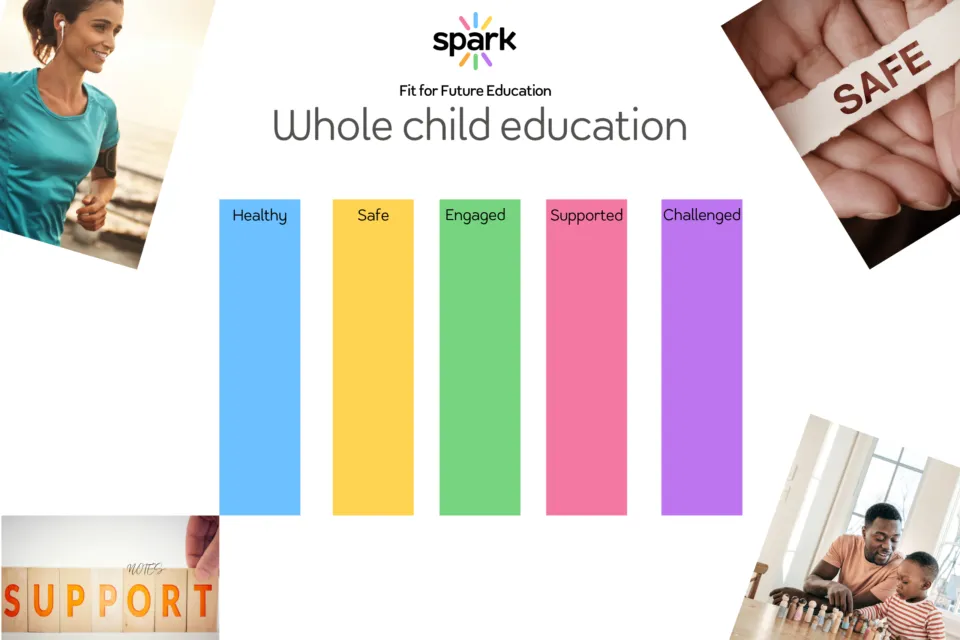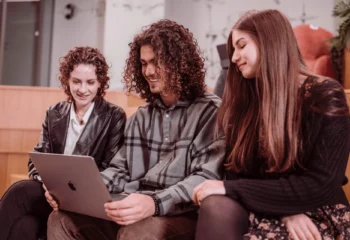Social and emotional skills are a focal point in a child’s education.
A lot of work and innovation happens in education to cover the essential areas of development a child needs. At the core – it is about having a humanizing approach to teaching and learning.
We all want the best education for our children. But sometimes, as parents, as we are not educators, we do not know the whole meaning of “the best” for our children.
That is why I say those in charge of teaching our children know best, and they should have the proper access to different capacities of development a child needs.
What does “whole child” mean
For many, this new combination of words that refers to education is relatively new. However, for Spark School is not.
But let’s get back to the beginning. The whole child idiom means that education does not mean only academics. It focuses on all areas of a child’s development – from social-emotional, cognitive skills to understanding courses like science, math, history, and others.
More than this, it puts great importance on the human spirit. With the aid of human nature, we can learn to accept ourselves, grow, and learn other things.
Six core elements of developing the whole as a person
Emotional
Physical
Spiritual
Social
Psychological
Professional
The goal
The whole person education has many goals, and they all start with the person. The focus is on the person and not what he can do for society but on becoming a part of society.
One of the goals is to create active lifelong learners and find long–term success. And for this, they have to feel a sense of belonging, and they need to acknowledge the community they are a part of.
After this, they will be in peace with what they are, who they are, how they can give back and where they belong.
Without a complete understanding of oneself, one cannot be known as a whole person.
When does this education start?
It can start as early as the age of preschool children and when they make the transition from kindergarten.
It can continue throughout your school years depending on the school you choose.
However, if it didn’t start early age, there is no issue, as it is never too late to start.
Developing the whole person is a program that can be very well used in high school students. That is a time when they pass through a new stage in their life when they prepare to take on new responsibilities and think of their future.
The role of schools
Education is core to the whole child development. Schools that focus on this make sure their programs ensure their students are healthy, safe, engaged, and challenged.
They do their best to
Make sure education and health go hand in hand and focus on improving a child’s cognitive, physical, social, and emotional development. The social-emotional skills development will help children tackle and manage stress while also boost social skills such as empathy.
Pay attention to bullying and plan accordingly to prevent it.
Support teachers and their development to make sure they are ready to come to students’ needs.
Create an environment that promotes strong relationships among staff, students, and families. This will help with the development of safety and belonging, which are essential to learning.
Include extended learning opportunities and community partnerships in the integrated school system.
Making students feel safe and supported, they have a more remarkable ability to succeed in school and life.
What do you need to know as a parent?
As we are not teachers at heart but desire to know what our children learn and how to look at the tips below, and hope they will help you get an idea.
Movement – this is imperious for children to get to know their bodies. As children are allowed to move freely, they will learn and see that you respect their needs.
Use all the four senses to learn – smell, see, hear and taste.
Engage both the right and the left sides of the brain
The wellbeing of the whole child
Understand that a child is an interconnected person. More than knowing they belong to a community, they gain respect towards other gatherings.
While we do not have a teaching background as parents, we must know and accept that learning doesn’t t start and end at school. This is an ongoing process, and we have to be there for our children to help them through and create cohesion between classes and home.
How can it help?
No matter the age this program starts at, it indeed has an essential role in the wellbeing of a child or student.
More than this, it challenges students to draw their conclusion, develops their critical thinking and makes them see that it is more to the world than academics.
Academics come to their help to see different aspects, take their conclusions, and guide them to commit to being active in the community.
“Whole person education enables the United Board and the colleges and universities in its network to infuse academic life with new purpose. “Nancy Chapman, United Board President https://unitedboard.org/programs/learn-whole-person-education/
Spark School approach
Spark Hybrid International High School allows students to be a part of a high–quality and holistic education program. We treat students as whole multidimensional beings and desire to create an environment that meets their social, emotional, spiritual, and cognitive needs. While this is a hybrid learning program, it sure can make students feel they are listened to, cared for, respected, and allowed to create their educational path and personal one.
We base our education on four main strands – academics, wellbeing, leadership, and global awareness. Each of them focuses on the students and their healthy development. More than this, the IDEAS Student Societies focusing on Internationalism, Democracy, Environment, Adventure, and Service help them build a strong personality and make a real difference in each of the five big projects.
Conclusion
The educational system that focused only on transmitting information, memorizing it, and repeating it in the same form is no longer what our society needs, not what our children need. At some point in our studying years, we were considered robots and teachers alike – us robots to learn and robots to teach what they are told is good. It is all about fostering the capacity to make a difference while being you and discovering you. It is not about putting a label; it is about every one of us as a person. This narrow focus on learning and education did not allow us to develop the whole being – as we are multidimensional beings and our identities are complex and rich.
There are scientific researches that prove the whole child education system is what children need today. This type of learning is not just desirable it is necessary. “Schools support developmental relationships when they foster key conditions for learning: emotional, intellectual, and physical safety; connectedness; support; challenge; engagement; respect and agency.” (Berkowitz et al. 2016, A Research Synthesis of the Associations Between Socioeconomic Background, Inequality, School Climate, and Academic Achievement)
Check some of the whole child approaches to education indicators in the Infographic.
To make sure children develop in their complexity and humanity, schools, parents, and caregivers need to have an integrated approach. More than this, be sincere. Students need to feel support, to see you are genuinely there when they need it. Try to get to know them as individuals, build a strong relationship with them and teach them it is good in everyone.




